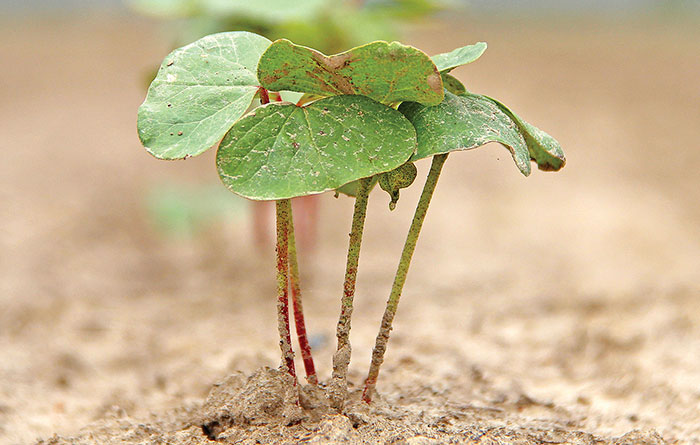
How are you planning to cut costs in 2016? One cotton grower claims he’s keeping a paper shredder beside him. That might help, but producers need a more systematic approach to surviving over the next few months.
“The only way that I’ve found to decrease cost is to increase yield,” says crop consultant Jack Royal, who lives in Leary, Ga. “Do everything possible to make the highest yield.
“With the cotton varieties that we have now, we’re pushing 3.5- and 4-bale limits, so there’s no way you can cut fertility. I also would manage my irrigation closely. And spray timely if you have insects.”
Royal says one area a cotton grower might be able to save on in 2016 is seed cost. “That’s our most expensive input,” he says. “Due to glyphosate-resistant Palmer amaranth, some cotton growers think they have to pay extra for weed control technology traits. If they start clean, and hammer weeds early, they can eliminate that extra cost.”
Royal said his growers plant the highest-yielding varieties they can find, but they may not have all the bells and whistles — “they’re just Bollgard II/ Roundup Flex varieties. We mainly plant three varieties that consistently yield 200 to 400 pounds better than other varieties.”
When Royal’s growers go into the field, it’s completely clean, whether it’s from a burndown and/or conventional tillage. Then they apply residual herbicides to hold weeds until they get planted.
“I also recommend that growers use a yellow herbicide,” Royal adds. “Then they can come back behind the planter with something like a Reflex and a Warrant tankmix, which does an excellent job of holding pigweeds. When cotton emerges, growers can make a timely application of Sequence or Roundup/Dual to help hold the pigweed.”
Additionally, Royal pays close attention to insects. “Research shows that some bollworm oversprays definitely increase yields in our Bollgard II varieties,” he says. “If we find bollworms in the field, we’ll tank mix $2.50 worth of pyrethroid with our plant growth regulator, normally adding 100 to 200 pounds of yield. An 100 extra pounds even at 60 cent cotton is $60 per acre.”
Disease-tolerant varieties
Arkansas crop consultant Eddy Cates notes that tight budgets mean cotton growers are more selective on variety selection. “We try to maximize our varieties; in 2015, we planted only one or two, but this year we will spread our risk and plant three or four varieties,” says Cates, who lives in Marion, Ark.
“We closely review each variety’s disease package as well as its high yield potential and fiber quality. We primarily have verticillium wilt and bacterial blight. Bacterial blight seems to be our biggest cotton disease problem year in and year out. We have several varietal options for bacterial blight, as well as vert.
“That’s why I’m recommending growers plant more varieties in 2016 than they planted in 2015. We can plant bacterial blight-tolerant varieties in fields with a history of the disease, and verticillium-tolerant varieties in vert-infected fields.
“I’m not aware of varieties that are tolerant to target spot, which showed up in our area in 2014 and 2015. We’ll recommend a fungicide application if it’s needed.”
Cates also recommends fine-tuning the fertility program, particularly keeping the potash level high in cotton soils. “Potash is the No. 1 component of cotton fertility management,” he says. “We especially don’t want to deprive cotton of potash in our silt loam soils. We might be able to cut back a little on phosphate, but potash is something we really do not want to cut back. University recommendations range from 40 to 50 units of potash per bale, but we average 90 to 120 units of potash.”
Cut costs, not yield
Cotton growers can trim production costs and still make great yields, says west Texas crop consultant Mark Scott. “We watched costs closely last year, were blessed with rain and made some great yields,” says Scott, who lives in Lubbock, Texas. “Some of our growers made a bale-and-a-half dryland cotton, and some made 4- and 4.5-bale irrigated cotton.”
One cost-cutting measure that Scott suggests is making sure the crop has the fertility that it needs for maximum yield potential for 2016 — and nothing more. “Instead of building our soil fertility, we’re trying to apply only the amount of fertilizer that’s needed to make this year’s crop.”
The Texas consultant also notes several growers plan to plant a little conventional cotton to cut costs. However, what they save in seed cost they might lose in weed control if they’re not careful.
“Glyphosate-resistant Palmer amaranth is a major problem for us,” Scott says. “I found some of the first resistant pigweed in the area five years ago. We can manage it real well with a burndown and pre-emergence herbicides. However, in 2015, heavy rains messed up our program because we couldn’t get into the field. One grower caught 17 inches of rain in 10 days.
“So now, some growers feel the only way they can control pigweed is with 2,4-D or dicamba cotton if they’re labeled. These will be good control options when they become available, but we still can control pigweed successfully with burndown and pre-emergence herbicides, and cultivation. However, because of economics, many of our growers have grown so large that they no longer have the manpower and equipment to cultivate like we did back in the 1980s.”
About the Author(s)
You May Also Like




